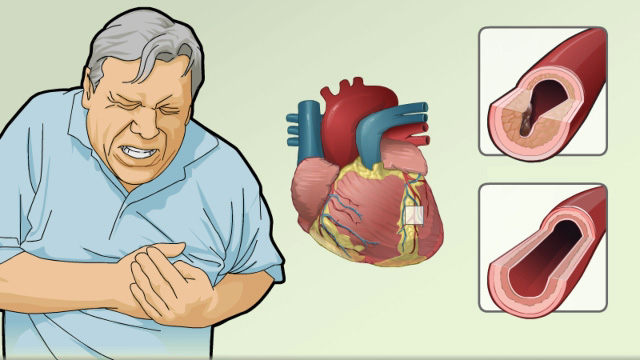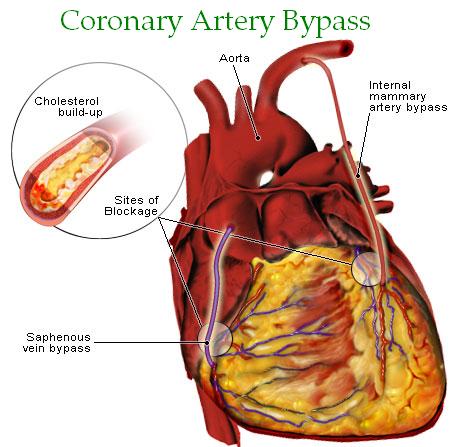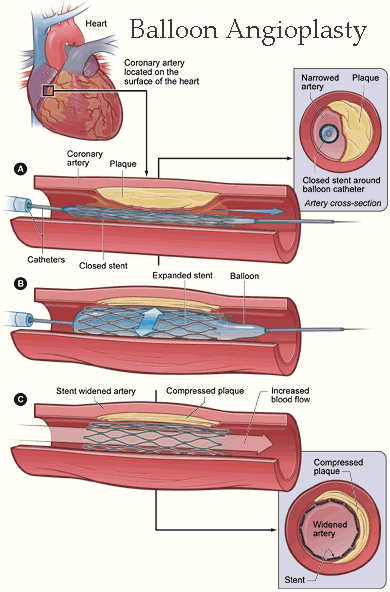Last Updated on September 19, 2024
Contents
- What Causes Atherosclerosis?
- What are the Symptoms of CAD?
- What does Angina Feel Like?
- Medication
- What is a Coronary Artery Bypass?
- What is Balloon angioplasty?
- What are Coronary Stents?
Atherosclerosis is a term that is more commonly known as ‘hardening of the arteries’. It refers to a condition that causes the arteries supplying the heart with blood to become narrow and stiff. This results in partial blockage of the flow of oxygen-rich blood to the heart.
Because the heart not receiving as much oxygen as it needs, CHEST PAIN (angina) may occur. If a clot comes free and totally blocks blood supply to part of the heart, a heart attack will occur. CORONARY ARTERY DISEASE (CAD) is the most common form of heart disease and refers to the heart condition caused by Atherosclerosis.
What Causes Atherosclerosis?
Hardening and narrowing of the arteries is caused by the accumulation of cholesterol and other fatty substances (called plaque) on the walls of arteries. Plaque causes flow of blood to the heart to slow down.
What are the Symptoms of CAD?
- The early warning signs of CAD include fatigue, pain and/or dizziness.
- Angina is a type of temporary chest pain, pressure or discomfort that occurs when the heart needs extra oxygen. When a person experiences angina only when exercising or engaged in activity the condition is called ‘stable angina’. If a person experiences angina even when resting the condition is called ‘unstable angina’.
What does Angina Feel Like?
Unless you are under a doctor’s care for angina and have strict instructions on how to handle an attack, you should get emergency help at once if you experience any of the following angina symptoms, as there could be a sign of a heart attack. Chest pain, pressure or a vague chest discomfort is most often used to describe angina. It may feel like a squeezing vice or crushing pressure deep in the chest behind the breastbone and may also be felt in shoulders, arms, back, neck or jaw.
The feeling of angina pain can vary from person to person and can be brought on by different activities that include:
- Cigarette smoking
- Eating and digesting a heavy meal
- Increase physical activity, such as walking r climbing stairs
- Strong motions, such as anger or frustration, even while dreaming
- Sudden changes in temperature or attitude
Medication
Management of CAD and angina involves a combination of prevention and treatment strategies.
- Cholesterol Management Medications – help to prevent the formation and worsening of plaque on the walls of arteries.
- Blood Pressure Lowering Medications – help to reduce the work that the heart has to do and prevent the formation of plaque.
- ASA – in a dose of 81mg to 325 mg daily can significantly reduce the risk of heart attack in people who have been diagnosed with coronary artery disease. Always discuss the benefits and risks with your doctor before starting to take this medication on your own.
- Beta Blockers – (e.g. metoprolol, atenolol) slow the heart’s resting rate and reduce the force of heart muscle contraction and the heart’s work load.
- Calcium Channel Blockers (e.g. amlodipine, verapamil) increase the blood flow through the heart and may reduce the workload of the heart by reducing the strength of contraction of the heart.
- Nitrates – (e.g. nitroglycerin, isosorbide) widen or dilate the walls of blood vessels. This allows more oxygen-rich blood to reach the heart and lessens he pain associated with angina attacks.
Surgical Procedures for Treatment of CAD
What is a Coronary Artery Bypass?
A Coronary artery bypass graft is open-heart surgery that involves taking a section of a blood vessel from another part of the body (e.g. the leg or chest ) and relocating it above and below the clogged portion of the artery that has been blocking the free flow of blood to the heart.
The operation usually takes 3 to 6 hours, depending on how many blood vessels need to be sewn together (grafted). People who have had the surgery report that their heath is much improved in over 90% of the cases.
It is important to understand that Coronary Artery Bypass Graft Surgery is not a cure for CAD. Therefore, it is vital that measures to prevent hardening of the arteries (e.g. exercise, hear healthy diet, appropriate medications) be continued.
What is Balloon angioplasty?
Balloon angioplasty, also known as percutaneous trans-luminal coronary angioplasty (PTCA) is a procedure where the surgeon pushes the plaque on the walls of the clogged artery back against the artery wall.
This allows for better blood flow through the artery. The procedure is accomplished by the insertion of a thin plastic tube (Catheter) into an artery. The doctor guides the catheter into the large artery (AORTA) that send blood from the heart to the rest of the body from there into the Coronary Artery.
Once the catheter is in place (at the part of the artery that is narrowed), the balloon tip is inflated and pushes the plaque against the artery walls. Angioplasty allows the blood to flow more freely to the heart. The procedure is effective about 85-90% of the time, but up to 35% of people experience re-blocking of their artery within 6 months. If this happens, a second angioplasty may be considered.
What are Coronary Stents?
An expandable mesh tube or ‘stent’ made of high quality stainless steel is place over the balloon used in the angioplasty procedure and left in place to help keep the plaque pushed back. Although the long-term effectiveness of the procedure is still under investigation, it may reduce the chances of needing a second angioplasty.
Written by: Winter Rose
Copyright © by www.siyalla.com
[Earlier our website was www.ehealthut.com]




